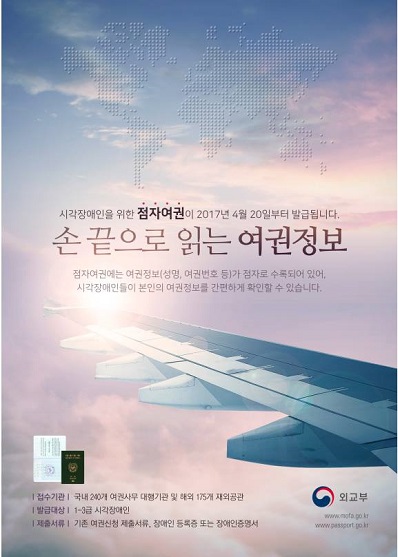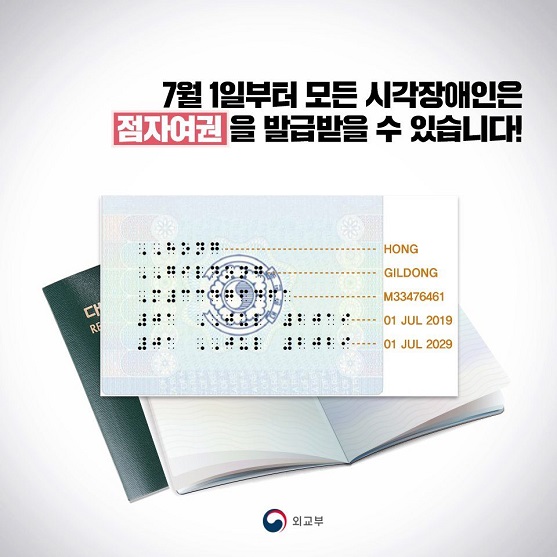The “Firsts” and “Bests” of Government Innovation
The Korean Government will accredit the “Firsts” of our innovations that contributed to the public’s comfort and safety, and select the “Best” cases of government innovation to spread as examples to our many institutions.
The First
The Braille Passport
- Ministry of Foreign Affairs
- 2023-12-20

The Ministry of Foreign Affairs (MOFA), in July 2017, implemented braille passports for the first time in the world. The 250,000 visually impaired citizens of Korea can all check their own passport information when travelling abroad. |
Contents √ Overview |
■Braille passports, “available at the fingertips” of the visually impaired
Not many people may know that braille passports, which allow the visually impaired to travel abroad with ease, were first implemented in Korea
Braille passports are specialized passports
for the visually impaired, issued by the ROK MOFA for the first time in the
world to allow visually impaired citizens to confirm the information on their
own passports. Braille passports are issued by attaching a transparent sticker
marked with key passport information, including names, passport number, and
date of issue and expiry, on to the back of the front cover of a regular
passport.
In the beginning, only individuals of level 1 to 3 visual impairment were eligible to issue braille passports, but starting from July 2019, all individuals with visual impairment were permitted to apply for braille passports.
The process of applying for braille passports
has also been simplified. Applicants are no longer required to provide any
documentation, such as a disability registration card, to confirm their
disability status. With the applicant’s consent, their level of disability can
be automatically verified on the public administrative information network.
The issuance of braille passports has
significantly increased actual convenience, as the visually impaired can now
easily confirm their information, no longer having to hassle with checking
their information whenever visiting overseas, or reserving flights and
accommodations.
👇The History of Implementing the Braille Passport👇 √ The Ministry of Government Legislation (MOLEG) opened ideas from the public for “Lawmaking for the Happiness of Citizens”, receiving the suggestion of braille passports. (2015.06.) √ Partial reform for passport legislation was proposed for new provisions to issue braille passports to the visually impaired, led by legislators including congressman Joo Seung Yong. (2016.06.) √ The 「Passport Act」 is amended to provide base rules for issuing braille passports (2017.03.21.) √ First issuance of braille passports for Level 1~3 visual impairment (2017.04.20.) √ Braille passport issuance, expanded to all visually impaired individuals (2019.07.01.) ⟹In the spirit of a proactive administration that realizes legal benefits that increase convenience for individuals with disabilities, the target group for issuance was expanded prior to amendment of the 「Passport Act」 √ Plan to partially amend legislation within the Passport Act, proposed by lawmakers including congresswoman Choo Mi-ae (2019.08.16.) √ The 「Passport Act」 is amended to expand implementation of braille passports (2021.01.05.) |
In 2017, the first year of issuance, 131 braille passports were issued, and as of the end of March 2023, a total of 958 passports have been issued.
The UN’s Convention on the Rights of
Persons with Disabilities (CRPD), relating to the matter of freedom of
expression, opinion, and information access for persons with disabilities,
advises convention signatories to improve and support convenience in
communication for sign language and braille. The world’s first braille passport
actively incorporated this initiative, leading to organizations and groups
working for the rights of the visually impaired around the world, including the
World Blind Union (WBU), to spread news of Korea’s issuance of braille
passports.
Following Korea’s braille passport policy in action, in June 2018, Portugal became the first nation in the EU to introduce a braille passport policy in the form of a braille page included in passports. Braille passports are gradually expanding to other nations, with the UK implementing a braille sticker (with name, expiration date, and the word “Passport” in braille) similar to that of Korea, and nations like Finland, Nicaragua, Kenya etc. favorably reviewing the implementation of braille passports.


